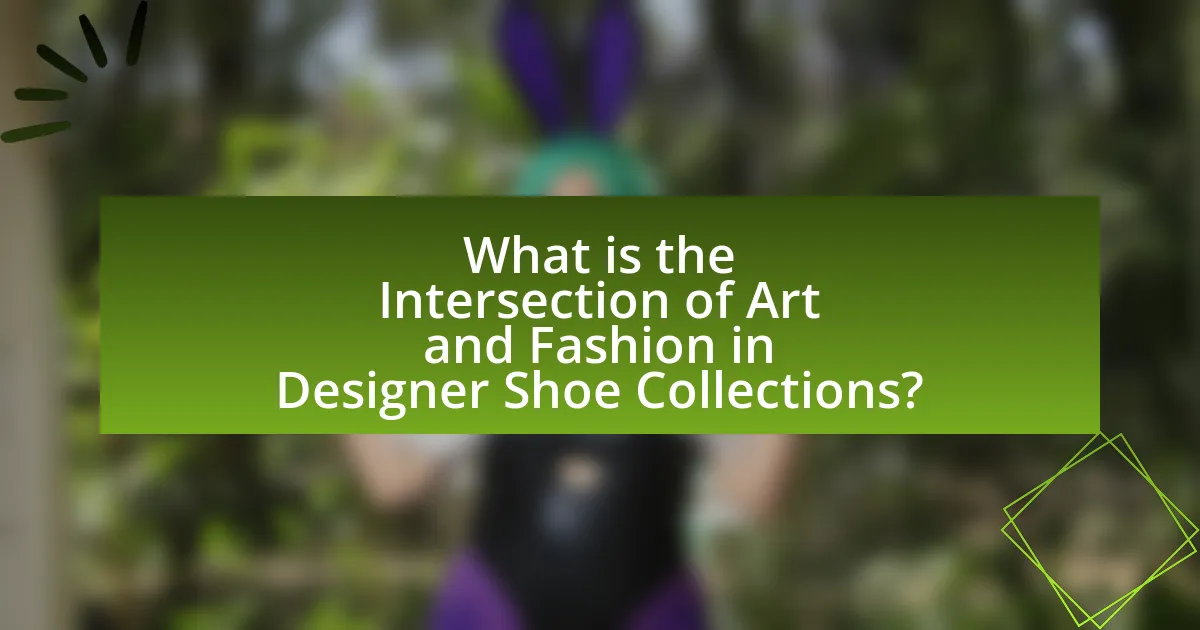The article explores the intersection of art and fashion within designer shoe collections, highlighting how artistic expression and innovative design combine to create footwear that is both functional and aesthetically significant. It examines the influence of various art movements on shoe design, the role of collaborations between artists and designers, and the impact of cultural context on trends in footwear. Key elements such as color, form, texture, and pattern are discussed, along with the significance of sustainability and technology in contemporary shoe design. The article also provides insights into how consumers can identify and appreciate the artistic value of designer shoes.

What is the Intersection of Art and Fashion in Designer Shoe Collections?
The intersection of art and fashion in designer shoe collections manifests through the integration of artistic expression and innovative design, resulting in footwear that serves as both functional items and wearable art. Designers like Christian Louboutin and Manolo Blahnik often draw inspiration from various art movements, incorporating unique materials, colors, and shapes that reflect artistic concepts. For instance, Louboutin’s use of bold colors and intricate embellishments echoes the vibrancy found in contemporary art, while Blahnik’s designs often reference historical art styles, showcasing craftsmanship akin to fine art. This blending of disciplines not only elevates the aesthetic value of shoes but also positions them as collectible art pieces, appealing to both fashion enthusiasts and art collectors alike.
How do art and fashion influence designer shoe collections?
Art and fashion significantly influence designer shoe collections by inspiring innovative designs and aesthetic choices. Designers often draw from artistic movements, such as surrealism or minimalism, to create unique footwear that reflects contemporary cultural trends. For instance, the collaboration between artist Yayoi Kusama and Louis Vuitton resulted in a collection featuring her iconic polka dots, merging fine art with high fashion. This intersection not only enhances the visual appeal of the shoes but also elevates their status as collectible art pieces, demonstrating how art can transform functional items into expressions of creativity and style.
What are the key elements of art that are incorporated into shoe design?
The key elements of art incorporated into shoe design include color, form, texture, and pattern. Color plays a crucial role in evoking emotions and attracting attention, as seen in collections by designers like Christian Louboutin, who uses vibrant hues to create visual impact. Form refers to the shape and structure of the shoe, which can reflect artistic movements; for example, sculptural heels often draw inspiration from modern art. Texture adds depth and interest, with materials like leather, suede, and textiles contributing to the overall aesthetic. Pattern, including prints and embellishments, enhances visual storytelling, as demonstrated in collections by brands like Gucci, which often feature intricate designs. These elements collectively contribute to the artistic expression within shoe design, bridging the gap between fashion and art.
How does fashion dictate trends in designer shoe collections?
Fashion dictates trends in designer shoe collections by influencing design aesthetics, materials, and consumer preferences. Designers closely observe runway shows, street style, and cultural movements to align their collections with current fashion narratives. For instance, the rise of sustainable fashion has led many designers to incorporate eco-friendly materials into their shoe lines, reflecting a broader societal shift towards environmental consciousness. Additionally, seasonal color palettes and styles showcased in fashion weeks directly impact the types of shoes that become popular, as seen with the resurgence of platform shoes and chunky sneakers in recent years. This responsiveness to fashion trends ensures that designer shoe collections remain relevant and appealing to consumers.
Why is the collaboration between artists and shoe designers significant?
The collaboration between artists and shoe designers is significant because it merges creative expression with functional design, resulting in unique footwear that transcends traditional fashion boundaries. This partnership allows artists to infuse their distinctive styles and narratives into shoe designs, creating limited-edition collections that appeal to both art enthusiasts and fashion consumers. For instance, the collaboration between Nike and artist Takashi Murakami produced sneakers that featured his iconic floral motifs, which not only enhanced the aesthetic value of the shoes but also elevated their cultural significance. Such collaborations often lead to increased brand visibility and sales, as they attract diverse audiences and generate buzz in both the art and fashion industries.
What are some notable collaborations in the industry?
Notable collaborations in the intersection of art and fashion in designer shoe collections include the partnership between Nike and artist Virgil Abloh, which resulted in the “The Ten” collection, blending streetwear with high fashion. Another significant collaboration is between Adidas and designer Raf Simons, known for its innovative designs that merge contemporary art with footwear. Additionally, the collaboration between Converse and artist Keith Haring produced limited-edition sneakers featuring Haring’s iconic artwork, showcasing the fusion of artistic expression and fashion. These collaborations exemplify how brands leverage artistic talent to create unique, culturally relevant products that resonate with consumers.
How do these collaborations enhance the value of designer shoes?
Collaborations between designers and artists enhance the value of designer shoes by infusing unique artistic elements and cultural significance into the footwear. These partnerships often result in limited-edition releases that attract collectors and fashion enthusiasts, thereby increasing demand and perceived exclusivity. For instance, the collaboration between Nike and artist Travis Scott led to the creation of the Air Force 1 “Cactus Jack,” which sold out quickly and has since become a sought-after item, demonstrating how artistic collaboration can elevate a product’s market value. Additionally, such collaborations often generate media buzz and social media engagement, further amplifying the brand’s visibility and desirability in the competitive fashion landscape.
What role does cultural context play in the intersection of art and fashion?
Cultural context significantly influences the intersection of art and fashion by shaping aesthetic values, themes, and consumer perceptions. For instance, the emergence of streetwear as a fashion trend reflects urban culture and artistic movements, such as graffiti and hip-hop, which have roots in specific cultural environments. This interplay is evident in designer collaborations, like those between artists and fashion houses, where cultural narratives are expressed through footwear designs, such as the limited-edition sneakers inspired by contemporary art. Furthermore, cultural context informs the symbolism and functionality of fashion items, as seen in traditional garments that carry historical significance, thus merging artistic expression with cultural identity.
How do cultural movements influence shoe design?
Cultural movements significantly influence shoe design by shaping aesthetic preferences, materials, and functionality. For instance, the punk movement of the 1970s introduced designs featuring bold colors, unconventional materials like leather and metal, and elements such as studs and spikes, reflecting the rebellious spirit of the era. Similarly, the rise of streetwear culture in the 1990s led to the popularity of sneakers that combined comfort with high fashion, as seen in collaborations between luxury brands and athletic companies. These shifts in design not only respond to the values and attitudes of the time but also serve as a medium for self-expression, making shoes a canvas for cultural commentary.
What are examples of cultural themes reflected in designer shoe collections?
Designer shoe collections often reflect cultural themes such as heritage, social movements, and global influences. For instance, brands like Balenciaga and Gucci have incorporated elements of street culture and activism into their designs, showcasing themes of rebellion and individuality. Additionally, traditional craftsmanship from various cultures, such as African beadwork or Japanese textiles, is frequently featured, highlighting the importance of cultural heritage in contemporary fashion. These themes are evident in collections that celebrate diversity and challenge societal norms, reinforcing the idea that fashion serves as a medium for cultural expression and commentary.

How do Designer Shoe Collections Reflect Artistic Movements?
Designer shoe collections reflect artistic movements by incorporating design elements, color palettes, and thematic inspirations that align with specific art styles. For instance, the use of bold geometric patterns in shoes can be traced back to the influence of Cubism, as seen in collections by designers like Pierre Hardy, who often draws from modern art. Additionally, the vibrant colors and surreal forms in shoes designed by brands like Balenciaga echo the principles of Abstract Expressionism, showcasing a direct connection between footwear design and contemporary art movements. This relationship is further evidenced by collaborations between designers and artists, such as the partnership between Nike and artist Takashi Murakami, which merges sneaker culture with fine art, illustrating how fashion serves as a canvas for artistic expression.
What artistic movements have influenced designer shoe collections?
Designer shoe collections have been influenced by several artistic movements, including Surrealism, Minimalism, and Art Deco. Surrealism has inspired designers like Salvador Dalí, whose imaginative and dream-like aesthetics have been reflected in footwear designs that challenge conventional forms. Minimalism, characterized by simplicity and functionality, has led to sleek, understated shoe designs from brands like Calvin Klein and Jil Sander, emphasizing clean lines and a focus on materials. Art Deco, known for its bold geometric patterns and luxurious materials, has influenced collections that feature intricate detailing and opulent finishes, as seen in the works of designers like Christian Louboutin. These movements have shaped the creative direction of designer shoes, merging artistic expression with fashion.
How does modern art manifest in contemporary shoe designs?
Modern art manifests in contemporary shoe designs through innovative aesthetics, unconventional materials, and artistic collaborations. Designers often draw inspiration from abstract expressionism, minimalism, and pop art, resulting in footwear that features bold colors, geometric shapes, and unique textures. For instance, brands like Balenciaga and Nike have incorporated elements of modern art into their collections, showcasing designs that resemble sculptures or paintings. This trend reflects a broader cultural movement where fashion serves as a canvas for artistic expression, blurring the lines between wearable art and traditional footwear.
What historical art movements have left a mark on shoe fashion?
Historical art movements that have significantly influenced shoe fashion include Art Deco, Surrealism, and Pop Art. Art Deco, prominent in the 1920s and 1930s, introduced geometric shapes and luxurious materials, which can be seen in the sleek designs of high-heeled shoes. Surrealism, emerging in the 1920s, inspired unconventional and imaginative footwear designs, often incorporating unexpected elements and dreamlike aesthetics. Pop Art, which gained popularity in the 1960s, brought bold colors and graphic patterns into shoe fashion, reflecting the vibrant culture of the time. These movements collectively shaped the evolution of shoe design, merging artistic expression with functional fashion.
How do designers interpret art in their collections?
Designers interpret art in their collections by integrating artistic elements, themes, and techniques into their designs, creating a dialogue between fashion and visual art. This interpretation often involves analyzing the work of specific artists or art movements, which influences the color palettes, textures, and forms used in their footwear. For instance, designers like Manolo Blahnik have drawn inspiration from the surrealism of Salvador Dalí, resulting in shoes that reflect the whimsical and imaginative qualities of that art style. This approach not only enhances the aesthetic appeal of the collections but also elevates the shoes to a form of wearable art, allowing consumers to engage with art in a new context.
What techniques do designers use to incorporate artistic elements?
Designers incorporate artistic elements through techniques such as color theory, texture manipulation, and innovative materials. Color theory allows designers to create visually appealing combinations that evoke emotions and enhance aesthetic appeal. Texture manipulation involves using various surfaces and finishes to add depth and interest, while innovative materials, such as sustainable fabrics or unconventional components, push the boundaries of traditional design. These techniques are supported by the fact that successful designer collections often reflect artistic movements, demonstrating the synergy between art and fashion, as seen in collections inspired by famous artists like Van Gogh or contemporary street art.
How does the interpretation of art vary among different designers?
The interpretation of art varies among different designers based on their individual backgrounds, cultural influences, and personal philosophies. For instance, some designers may draw inspiration from classical art movements, incorporating elements like symmetry and color theory, while others might focus on contemporary art, emphasizing abstraction and conceptual themes. This divergence is evident in collections such as those by Christian Louboutin, who often references surrealism in his designs, contrasting with Manolo Blahnik, who frequently integrates historical art references. Such differences highlight how designers’ unique perspectives shape their artistic expressions in fashion, particularly in shoe collections.

What are the Trends in Designer Shoe Collections Merging Art and Fashion?
Trends in designer shoe collections merging art and fashion include the use of bold artistic prints, collaborations with contemporary artists, and the incorporation of sculptural elements. Designers like Balenciaga and Gucci have embraced vibrant colors and unique patterns, often inspired by modern art movements. Collaborations, such as those between Nike and artists like Takashi Murakami, showcase limited-edition releases that blend functionality with artistic expression. Additionally, sculptural designs, seen in collections from brands like Maison Margiela, challenge traditional shoe silhouettes, emphasizing creativity and craftsmanship. These trends reflect a growing consumer desire for individuality and artistic storytelling in fashion.
What current trends are emerging in the intersection of art and fashion?
Current trends at the intersection of art and fashion include the integration of digital art into clothing designs and collaborations between fashion designers and contemporary artists. For instance, brands like Balenciaga and Gucci have recently featured digital artwork in their collections, reflecting the growing influence of technology on fashion. Additionally, high-profile collaborations, such as those between Nike and artists like Takashi Murakami, showcase how artistic expression is being embraced in footwear design. These trends highlight a shift towards more innovative and expressive fashion, where art serves as a significant source of inspiration and identity.
How are sustainability and ethical practices influencing designer shoes?
Sustainability and ethical practices are significantly influencing designer shoes by driving brands to adopt eco-friendly materials and transparent production processes. Many designers are now prioritizing the use of sustainable materials, such as recycled plastics and organic cotton, to reduce environmental impact. For instance, brands like Stella McCartney have pioneered the use of vegan leather and sustainable textiles, showcasing that luxury can align with environmental responsibility. Additionally, ethical practices are prompting brands to ensure fair labor conditions and transparency in their supply chains, as seen in initiatives like the Fashion Revolution movement, which advocates for accountability in the fashion industry. This shift not only appeals to environmentally conscious consumers but also sets new standards for the industry, pushing more brands to integrate sustainability into their core values.
What role does technology play in the evolution of designer shoe collections?
Technology significantly influences the evolution of designer shoe collections by enabling innovative designs, enhancing production efficiency, and improving customization options. Advanced materials such as 3D-printed components and smart textiles allow designers to create unique aesthetics and functional features that were previously unattainable. For instance, brands like Nike and Adidas utilize 3D printing to produce lightweight and intricately designed shoe parts, which not only reduces waste but also accelerates the prototyping process. Furthermore, technology facilitates personalized shopping experiences through augmented reality and virtual fitting rooms, allowing consumers to visualize how shoes will look and fit before purchase. This integration of technology not only streamlines the design and manufacturing processes but also aligns with consumer demands for individuality and sustainability in fashion.
How can consumers identify artistic influences in designer shoes?
Consumers can identify artistic influences in designer shoes by examining design elements such as color, texture, and form, which often reflect specific art movements or artists. For instance, shoes inspired by abstract expressionism may feature bold colors and dynamic shapes, while those influenced by minimalism may showcase clean lines and neutral palettes. Additionally, collaborations between designers and artists, like the partnership between Nike and artist Takashi Murakami, provide clear examples of artistic influence, as these collaborations often incorporate recognizable artistic motifs and techniques. By analyzing these aspects, consumers can discern the artistic narratives embedded within the footwear.
What features should consumers look for in art-inspired shoe designs?
Consumers should look for unique artistic elements, quality craftsmanship, and comfort in art-inspired shoe designs. Unique artistic elements include bold colors, intricate patterns, and designs that reflect specific art movements or artists, enhancing the aesthetic appeal. Quality craftsmanship ensures durability and attention to detail, which is essential for maintaining the integrity of the artistic design. Comfort is crucial, as shoes should not only be visually striking but also functional for everyday wear. These features collectively contribute to a shoe’s value and appeal, aligning with consumer expectations in the intersection of art and fashion.
How can consumers appreciate the artistic value of designer shoes?
Consumers can appreciate the artistic value of designer shoes by recognizing the craftsmanship, innovative designs, and cultural influences embedded in each pair. Designer shoes often feature unique materials, intricate detailing, and creative silhouettes that reflect the designer’s vision and artistic expression. For instance, brands like Christian Louboutin and Manolo Blahnik are known for their signature styles that combine aesthetics with functionality, showcasing the artistry involved in their creation. Additionally, understanding the historical context and the designer’s inspiration can enhance appreciation; for example, many collections draw from art movements or cultural motifs, linking fashion to broader artistic narratives. This awareness allows consumers to see designer shoes not merely as fashion items but as wearable art that embodies creativity and cultural significance.
What are some practical tips for selecting art-inspired designer shoes?
When selecting art-inspired designer shoes, prioritize the alignment of the shoe’s design with your personal style and the artwork that inspires it. Consider the color palette, patterns, and overall aesthetic of the shoe, ensuring they resonate with your wardrobe and preferences. Additionally, assess the quality of materials and craftsmanship, as high-quality shoes not only enhance durability but also reflect the artistic intent behind the design. Research the designer’s background and their artistic influences to understand the context of the shoe’s design, which can enhance your appreciation and decision-making. Lastly, try on the shoes to ensure comfort and fit, as even the most artistic designs should be wearable.



